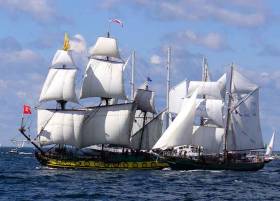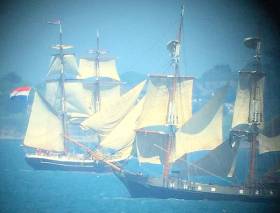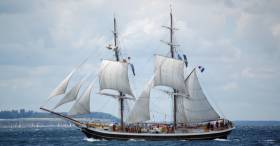Displaying items by tag: Morgenster
A New Tall Ship For Ireland? Would it Be Worth The Trouble?
As we move into March each year, throughout Ireland Tall Ships enthusiasts will wistfully recall that it was in March 1981 that Ireland finally commissioned her own Tall Ship, a national flagship worthy of our aspirations, the Jack Tyrrell-designed and Arklow-built 84ft brigantine Asgard II writes W M Nixon.
She gave years of excellent service and introduced young people from all backgrounds and every part of the country to the complete sail training experience at its very best. Yet although she was officially within the remit of the Department of Defence, in times of government expenditure cutbacks, the very existence of such an exotic creature in the amidst the workaday problems of running organisations with a military emphasis could be problematic.
Under a succession of talented and dedicated skippers with a small but devoted permanent crew, Asgard II was run in an efficient yet distinctly non-military, non-bureaucratic way. Even if at times it was done on a shoestring, it was all kept working, appearances were kept up with the vessel maintained by the crew, and the seemingly free-style system of command, while it had a core of disciplined pure steel at its heart, worked well to create a happy ship.
Nevertheless it could be argued that the unique and complex problems of running a small national sail training ship and her programme were about as far as could be from the instinctive abilities and traditional approach of the Irish Public Service mindset. But that said, the Irish public service has broad shoulders. There may not always have been total enthusiasm within it for having anything to do with running Asgard II. But it was always there in their In-tray, and they got on with it, with secretaries to Coiste an Asgard tending to give service way over and above the requirements of duty.
Yet being a Government-run ship, inevitably the viewpoint of whoever was Minister for Defence at the time affected the attitude to the Asgard programme. The realities of democracy intervened. At a national level, even in coastal constituencies, few if any votes were won or lost over whether the local TD vociferously supported the Asgard II sail-training programme. And if the current Minister for Defence happened to represent an inner-city constituency with little if anything in the way of deeply-engrained maritime traditions, Asgard II was way down the list of priorities.
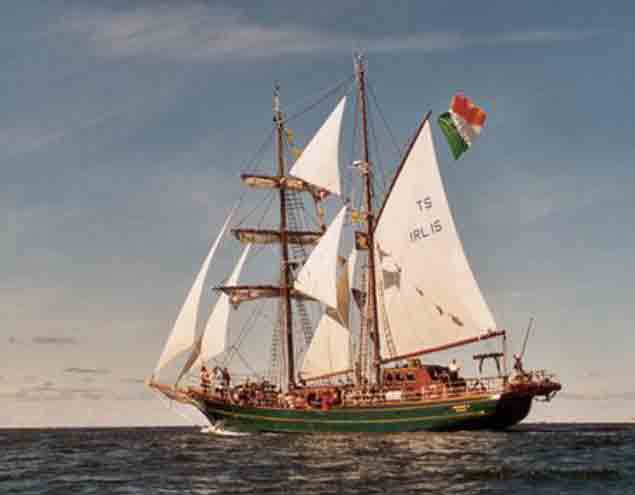 Thanks to devoted bos’uns and crew, Asgard II was always looking her best even when age was creeping up on her.
Thanks to devoted bos’uns and crew, Asgard II was always looking her best even when age was creeping up on her.
But she could be kept going – just - thanks to the ability of those running her to stretch resources to the limit and beyond. Yet with every passing season, the longterm problems were increasing. By the time she was sailing her 25th season in 2005, there were those who argued that a traditional wooden hull, with its single-skin planked construction, was no longer in compliance with increasingly complex regulations which required double-skin construction in a passenger-carrying boat, but Asgard II – with her limited number of trainees - was still able to pass regulations as a cargo-carrying vessel.
Then too, in the late noughties, Asgard was looking her very best with a devoted skipper and an extremely able bo’sun. But skilled painting, word-class varnishwork, and the necessary provision of a new and highly-visible set of immaculate spars, disguised the fact that if Coiste an Asgard had been given the funds to provide a replacement hull, the latest set of regulations would have insisted that it be double-skin. That in turn would have led to a raging public debate between those who would insist that Asgard III must be built in wood, and those who would reasonably point out that a double-skin wooden hull – with a safety gap between the skins as required by regulations – would be very space-consuming in a little ship which, even in her single-skin version, was already very crowded within her hull, and thus steel or even aluminium would provide the best way to go.
It all became very academic on September 8th 2008, when Asgard II sank off Belle Ile in the Bay of Biscay while on passage with a full crew of trainees from Falmouth in Cornwall towards the French port of La Rochelle. It started to happen shortly after midnight, and as she sailed along in reasonably pleasant late summer conditions, no-one on board had seemed aware of any impact with a submerged hazardous object, such as a container, which might have caused this sudden ingress of water.
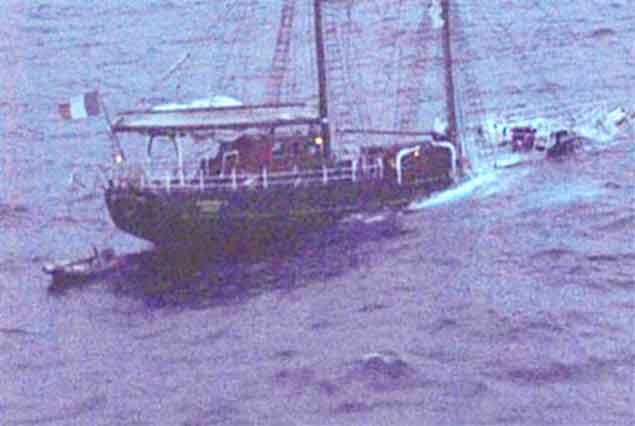 Monday, September 8th 2008
Monday, September 8th 2008
But it became such that the ship’s pumps couldn’t cope, and the captain’s first duty was to his trainees – it would have been irresponsible to spend precious time in the small hours of the morning calling up any ship which might happen to be in the neighbourhood, in the hope that she might have transferrable pumping systems which would have helped alleviate the problem.
The seamanlike thing was to declare the ship a hulk, and arrange her abandonment in an orderly manner. The only setback which arose in this action was the collapse of the floor in one of the large liferafts – a liferaft which had only recently been re-certified – but the people on it were transferred to other liferafts, and in due course the local lifeboat arrived and took everyone to Belle Ile while Asgard sank with a certain quiet dignity, and took up a position sitting on the seabed in 84 metres of water.
There were immediate calls for her salvaging as soon as possible, to be followed by full restoration and a resumption of sail training duties. But the senior officer of the Naval Service involved in the issue put it all in a harsh but necessary perspective: “Would you like your children to go to sea as trainees in a ship which has sunk in this way” he quietly asked, “when, however good the restoration, it is still the restoration of a vessel which inexplicably sank like this?”.
For however much you try to read into the official report, its results are not totally conclusive, and the reality is that the Asgard II sank, and sank quite quickly, after an impact of which no-one was aware. It’s very likely the sinking would not have happened had she been double-skinned. But any attempts to make a raised and restored Asgard II into a double-skinned vessel would have been an absurd waste and misdirection of resources.
Be that as it may, by this time, the Irish economy was in complete free-fall off a very high and steep economic cliff, and although the loss of the Asgard II was assuaged eventually by an insurance payout of €3.8 million, it was only within the sail training community that anyone protested against the transfer of these funds to the Department of Finance at a time when the national economy was on its knees with the Troika bail-out.
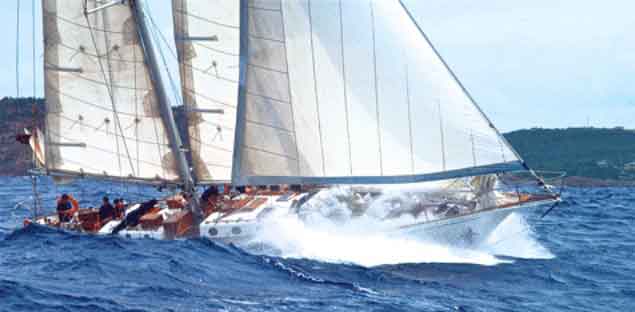 Spirit of Oysterhaven is licensed to carry 12 trainees
Spirit of Oysterhaven is licensed to carry 12 trainees
In fact, the Government – for the time being at any rate – was quietly exiting the sail training arena, and in 2011 all the remaining assets and functions of Coiste an Asgard were transferred to a new non-Governmental organisation, Sail Training Ireland, which set to work to find berths for Irish trainees on other ships in an international network which, partly thanks to the very favourable reputation which Asgard II had established for herself during her 28 busy years, has been working well as they’ve also brought in “private enterprise” training ships such as Oliver Hart’s yacht-like 70ft schooner Spirit of Oysterhaven, which has been awarded the Sail Training International Small Vessel Award for 2016, a really notable achievement in a crowded field.
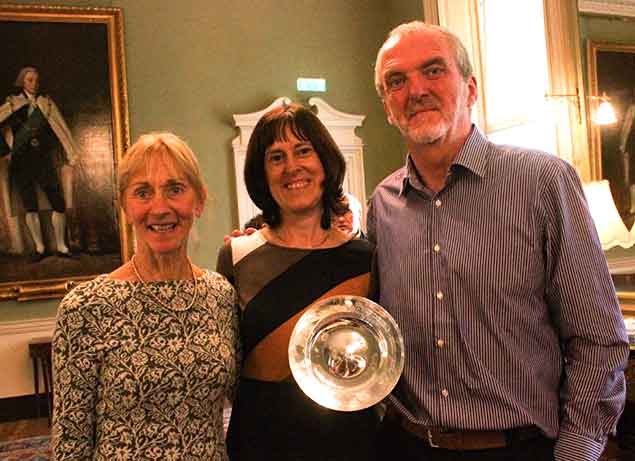 Kate Hart, Sinead Hurley and Gary Davis of Spirit of Oysterhaven. Winner of Sail Training International Small Vessel Award for 2016.
Kate Hart, Sinead Hurley and Gary Davis of Spirit of Oysterhaven. Winner of Sail Training International Small Vessel Award for 2016.
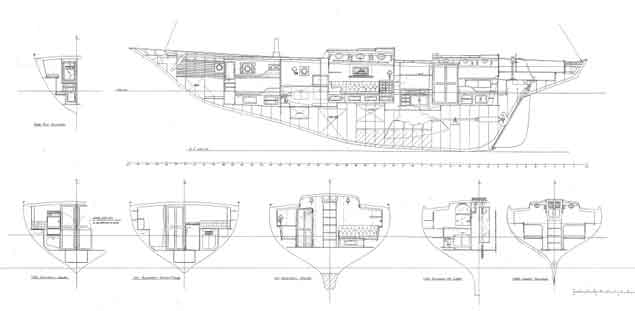 While sail training should be mainly about sailing, from time to time the vessels involved have to manoeuvre under power in very small harbours. Spirit of Oyserhaven’s lines are of special interest, as they reveal the designer has retained a straight leading edge on the rudder, thereby optimising the control benefit of propeller thrust even though the propeller is in an aperture in the long-keel hull.
While sail training should be mainly about sailing, from time to time the vessels involved have to manoeuvre under power in very small harbours. Spirit of Oyserhaven’s lines are of special interest, as they reveal the designer has retained a straight leading edge on the rudder, thereby optimising the control benefit of propeller thrust even though the propeller is in an aperture in the long-keel hull.
But inevitably a couple of years after the loss of Asgard, when her complete demise was finally accepted, voices were being raised in support of returning some day to the position of Ireland having her own sail training ship. It has to be said that these were for many years just a few voices crying in a wilderness, for in the near decade since Asgard II sank, Ireland has been a complete disaster area for tall ships and sail training vessels.
The litany of disaster is unbelievable. The only redeeming feature is that in a great tapestry of sinkings and groundings and the striking of rocks, not one life has been lost. But many dreams and careers have been utterly destroyed.
Appropriately, we’d had a rehearsal on RTE way back in 2003, when the traditional gaff schooner Carrie involved in the reality TV series Cabin Fever managed to come ashore on Tory Island, and soon broke up for the delectation of millions of viewers worldwide, with the whole sorry episode being on a loop on the screen in many a harbourside bar.
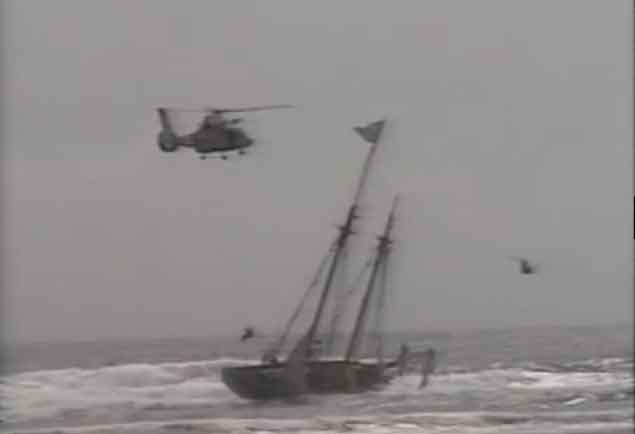 A video grab from RTE News of the Cabin Fever Ship aground
A video grab from RTE News of the Cabin Fever Ship aground
Then, even before the Asgard II story had been laid to rest, in 2010 the Northern Ireland Sail Training ship, the 80ft Oyster ketch Lord Rank, managed to impale herself on a rock northwest of Ballycastle in Rathlin Sound on the Antrim coast. Once again the incident got even more publicity than would have normally been expected, as they had a team from Downtown Radio on board to transmit a broadcast.
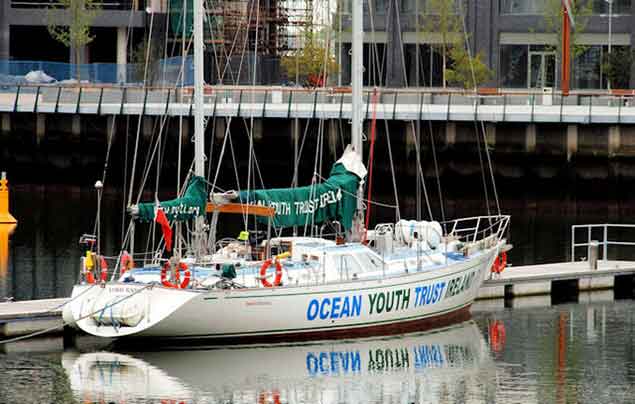 The Northern Ireland 80ft ketch Lord Rank sank within two years of Asgard II going down
The Northern Ireland 80ft ketch Lord Rank sank within two years of Asgard II going down
But a Bermudan rigged ketch on an isolated rock doesn’t make for nearly as spectacular a wreck as a proper Tall Ship destroying herself in against a cliff, and this epic was provided in 2013 when it was demonstrated that the road to hell is paved with good intentions.
Ireland was barely getting her nose above water after the bail-out, and in order to get things moving again on the tourism front – for who would want to be a tourist in a country in the depths of economic and psychological depression? – the Department for Tourism set up 2013 to be the Year of the Gathering, when people of Irish descent worldwide would be encouraged to return home for holidays in the Old Sod, the land of their ancestors.
Whether it was a bright idea or not is neither here nor there, as funds were lapped-up in order to pay for “Gatherings” such as family weddings. But the fact is that generally it was announced with little enough time to spare for anyone, other than those catering for people who make last-minute short-break holiday decisions, to make proper plans. Thus with only months to go, the Irish Sailing Association co-opted the Cruising Association of Ireland to put together a Gathering Cruise for visitors from Dublin Bay to West Cork, and while it attracted a turnout, the mood became more optimistic as they proceeded along the south coast, as it was learned that at Oysterhaven the little fleet would be joined by the 137ft Dutch Tall Ship Astrid, which at a stroke would maybe double the number of people taking part.
But the Irish weather and the fates in general would not let you get away with such a serendipitous turn of events. Following the Oysterhaven meet, the fleet were to parade round to Kinsale. But it was a dirty day of an onshore wind, and the old Astrid would need the help of her small auxiliary engine if she was going to make a suitably impressive entrance to Kinsale close by the cliffs.
Unfortunately, at a port of call earlier in her voyage from the Netherlands, Astrid had mistakenly had some fresh water put into her diesel tank. Though every effort had been made to remove it, the fuel was still contaminated and the engine cut out at the absolute crucial moment of rounding the headland immediately east of Kinsale.
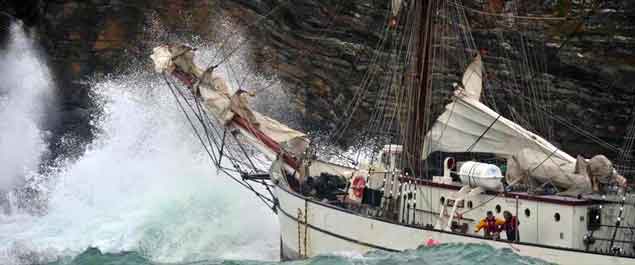 Death in slow motion. Astrid onto the cliffs outside Kinsale
Death in slow motion. Astrid onto the cliffs outside Kinsale
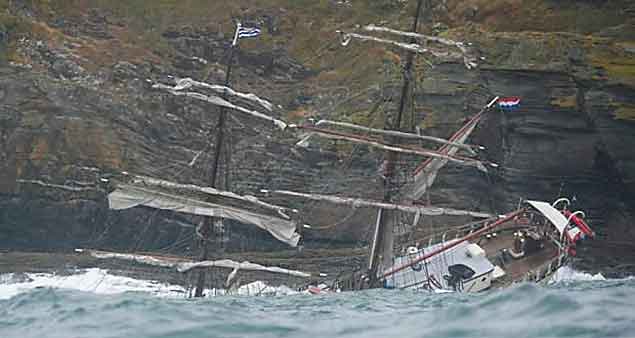 All hope gone. Astrid’s death throes.
All hope gone. Astrid’s death throes.
Unlike the Asgard II’s graceful departure, poor old Astrid had a long and lingering death in against those cliffs. It was a salutary lesson for everyone, for until then we’d tended to look to the Dutch as the very exemplars of a properly-run, indeed closely-regulated maritime nation. Yet it emerged that neither Astrid nor some of those involved in running her were properly certified to be taking trainees to sea.
We’re always told that we in Ireland are too lax in implementing European maritime law, working on the old Chinese saying that the mountains are very high, and the Emperor is far away. Admittedly, apart from Snowdonia in Wales, there are no mountains between Ireland and Brussels. But even so, things seem to be the other way round in any case – the nearer you get to the entre of power, the more relaxed is the observation of “petty” regulations.
In 2013 I’d already seen a demonstration of this when a large Dutch contingent arrived in Dublin as part of the Old Gaffers Association Golden Jubilee Cruise in Company. When we were in Dublin port, up the river came a Dutch character boat captain and his little dog in their tiny dinghy, and a classic Seagull outboard on the stern spluttering all sorts of pollution at a time when everyone else in Europe seemed obsessed with the compliance of regulations about changing to much heavier pollution-reducing four strokes, or making the big move to electric outboards.
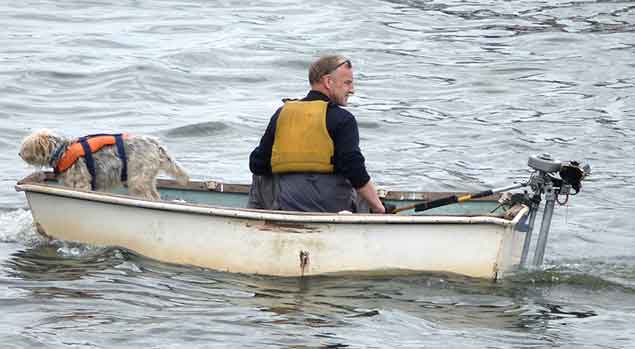 One man and his dog. In 2013, a Dutch Old Gaffer cruising the Liffey had scant regard for Directives from Brussels about doing away with old polluting outboards. But at least they were wearing lifejackets…..Photo: W M Nixon
One man and his dog. In 2013, a Dutch Old Gaffer cruising the Liffey had scant regard for Directives from Brussels about doing away with old polluting outboards. But at least they were wearing lifejackets…..Photo: W M Nixon
So all is not as it seems at the heart of Europe. And after the Astrid disaster those who might have though of using the highly-regarded Dutch marine industry as the source of a new vessel had to undertake further research until they were once again certain it was still the right thing to do.
But equally, after the loss of the Carrie, the Asgard II, the Lord Rank, and the Astrid, and after it had emerged that it was simply too costly to keep the Jeannie Johnston in Dublin and the Dunbrody in New Ross in certified condition as seagoing tall ships, instead of just using them as permanently-berthed visitor attractions, there inevitably has emerged a quiet but real body of opinion which reckons that Ireland having the luxury her own sail training tall ship simply isn’t worth the hassle.
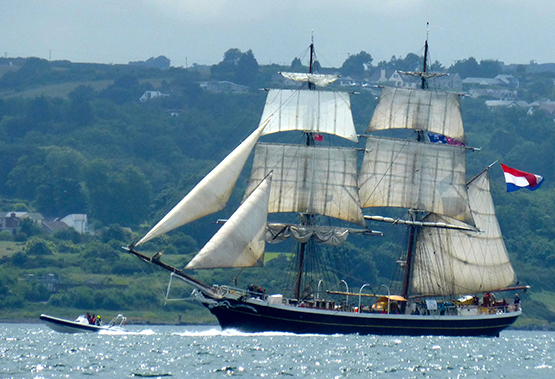 The Dutch ship Morgenster. Should we continue to send her a regular supply of trainees to save ourselves the trouble of running our own tall ship?
The Dutch ship Morgenster. Should we continue to send her a regular supply of trainees to save ourselves the trouble of running our own tall ship?
After all, Sail Training Ireland – now with Darragh Sheridan as CEO after Michael Byrne has moved on to fresh fields after several successful years – is running very smoothly in placing trainees in other European ships, with the Dutch vessel Morgenster in particular proving so popular that she is now almost honorary Irish.
As the STI programme has developed, well-wishers and organisations such as the Irish Cruising Club are finding it an attractive propositions to provide bursaries for young people to go to sea in a proper international tall ships situation through the STI’s current setup. It’s neat, tidy and manageable. And when winter comes, it’s not our concern whether or not the Morgenstern, and other ships that we in Ireland use, such as the splendid Europa, have to undergo a major refit or instead get themselves out to the Canaries for a profitable winter programme.
Thus as ever it was heartening to attend STI’s annual awards ceremony in Dublin’s Mansion House, and share the enthusiasm of an enormous diversity of young people each of whom had responded in their own favourable way to the Tall Ships experience.
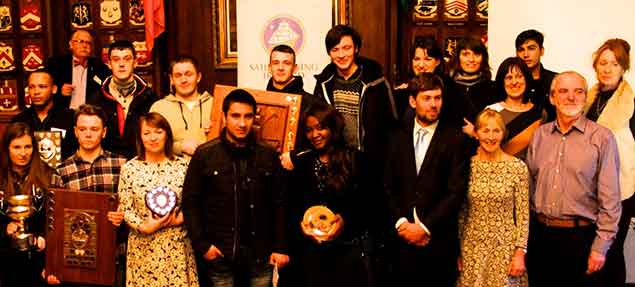 All the award winners at this year’s Sail Training Ireland ceremony in the Mansion House.
All the award winners at this year’s Sail Training Ireland ceremony in the Mansion House.
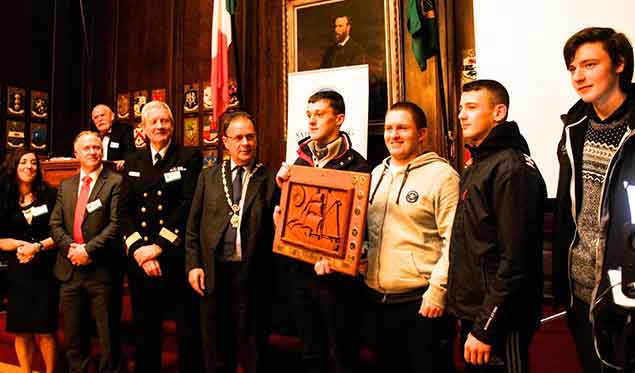 Presentation of the Cork Life Centre-Asgard Award with (left to right) Sara Mason & Daragh Sheridan of STI, MC Marcus Connaughton, Commodore Hugh Tully, Flag Officer Commanding Naval Service, and Dublin City Councillor Ruairi McGinley presenting the award to Stuart Barry, Danny O’Keeffe, William Cooper, and Colm O’Brien
Presentation of the Cork Life Centre-Asgard Award with (left to right) Sara Mason & Daragh Sheridan of STI, MC Marcus Connaughton, Commodore Hugh Tully, Flag Officer Commanding Naval Service, and Dublin City Councillor Ruairi McGinley presenting the award to Stuart Barry, Danny O’Keeffe, William Cooper, and Colm O’Brien
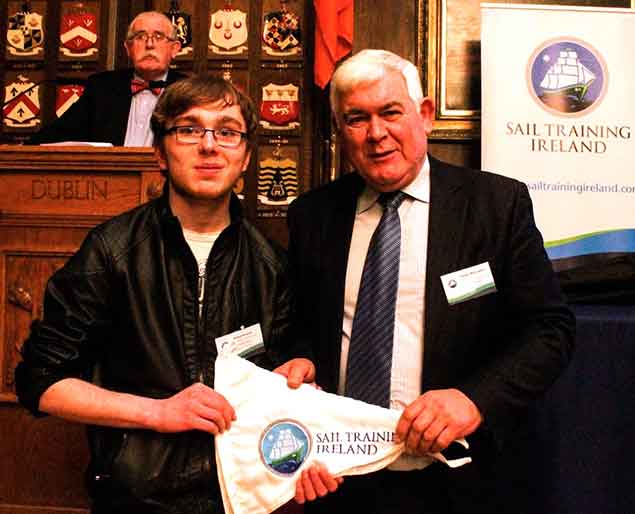 Nathan Howard (left) representing Tim Baker of Belfast, the awardee for Outstanding Achievement, with Seamus McLaughlin, Chairman of Sail Training Ireland
Nathan Howard (left) representing Tim Baker of Belfast, the awardee for Outstanding Achievement, with Seamus McLaughlin, Chairman of Sail Training Ireland The STI Outstanding Contribution award goes to Victor Springbok (right) with (left to right) Sara Mason & Daragh Sheridan of STI, Commodore Hugh Tully and Cllr Ruairi McGinley
The STI Outstanding Contribution award goes to Victor Springbok (right) with (left to right) Sara Mason & Daragh Sheridan of STI, Commodore Hugh Tully and Cllr Ruairi McGinley
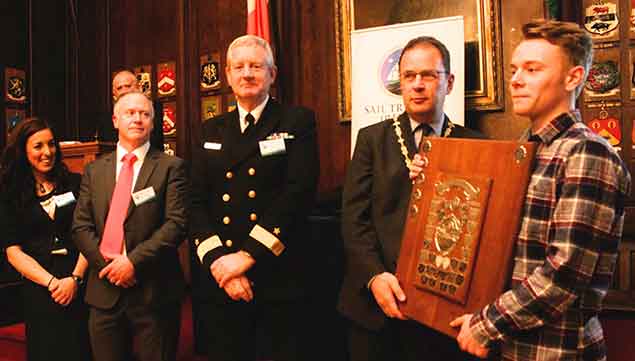 STI Trainee of the Year Ross Moore (right) with (left to right) Sara Mason, Daragh Sheridan, Commodore Hugh Tully, and Cllr Ruairi McGinley.
STI Trainee of the Year Ross Moore (right) with (left to right) Sara Mason, Daragh Sheridan, Commodore Hugh Tully, and Cllr Ruairi McGinley.
But then you couldn’t help but notice that in the Mansion House a popular guest, to whom everyone seemed to relate, was Neil O’Hagan, of the Enda O’Coineen-inspired Irish Atlantic Youth Trust. Their purpose is the creation of an all-island Irish Sail Training Ship, a 140ft three-masted barquentine based on the proven Spirit of New Zealand, and built in steel in the Netherlands by reputable designers and builders, while keeping open the option of having her builders provide a kit which can then be assembled here to become a ship built in Ireland.
To work, the project would need a considerable level of Governmental input and in Ireland’s always fluid yet somehow also rigid political situation, that is the Great Unknown. The Atlantic Youth Trust has offices in Dublin and Belfast to deal directly with Government even if the island’s real maritime capital is Cork, but resolving that will be another day’s work.
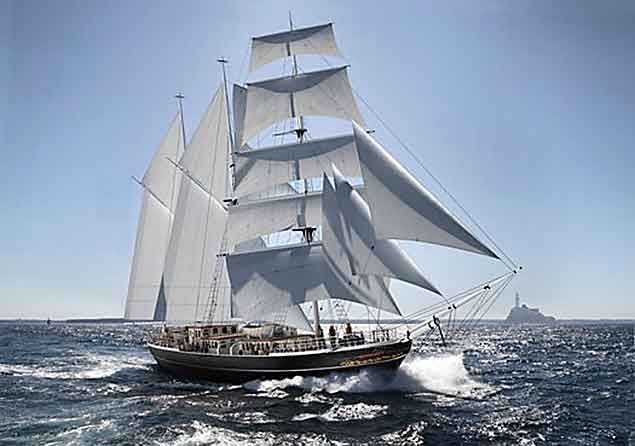 The vision. Concept image for the barquentine-rigged 40-metre Tall Ship proposed by the Atlantic Youth Trust
The vision. Concept image for the barquentine-rigged 40-metre Tall Ship proposed by the Atlantic Youth Trust
As it is, thanks to the influence of leaders such as Chairman Lord Glentoran, the Atlantic Youth Trust arranged a meeting with Peter Robinson MLA, the then First Minister of Northern Ireland. A Tall Ships gathering was shaping up in Belfast (when it happened, it was a notable success) so the mood was good for the delegation, and the First Minister warmly received the idea of a concept which would inevitably involve Government capital expenditure.
And then he made one request. He asked them to go along the corridor and put the idea to Deputy First Minister Martin McGuinness MLA, as that was the way shared power was meant to work. So along they went in some trepidation, and after the usual introductory pleasantries, they outlined the situation and were almost bowled over by Martin McGuinness’s enthusiasm.
Eventually, when they were taking their leave, they asked him why he had leapt at the idea so keenly. He replied that apart from it being a very good idea, it was maybe the first clearcut occasion on which the First Minister had received a proposal, and then without the usually inevitable closeting with his special advisors, had immediately given it a fair wind along to the Deputy Minister. It was how power-sharing was meant to work, but very rarely did.
It was a good start, but there was still a long way to go, for in tandem with their negotiations in the north they had to bring the Dublin government in as an equal partner. Here, the overall response was favourable but the complexities – involving a different structure of Government departments, not to mention all the movements in political mood - made it long hard going.
Meanwhile, there was a by-product which bears out the effect they’d had in the corridors of power in Stormont. Our northern correspondent Betty Armsrong was in Derry for the visit of the Clipper Fleet, in which the city had an entry, and came back enthusing about her new VBF Martin. It turned that while in the Maiden City, she’d spent some time in the company of Martin McGuinness whose enthusiasm for the entire waterborne pageant was total. “Admittedly” said he “the cost of supporting the boat and getting the visit seemed very high when we were being talked into this, but now that it is happening so well, it’s worth every penny”.
It would be ironic if the successful visit of the Atlantic Youth Trust to the office of the Deputy First Minister is in the end only recalled for the fact that Martin McGuinness was an increasingly enthusiastic supporter of major maritime events and projects. But the reality in Government is that the political personnel landscape is now entirely changed both north and south, and we’ll need the dust to settle before we can see where it’s all going.
Yet even as recently as November, Neil O’Hagan reckoned things were looking good, and he’s convinced they’ll come good again in due course. Back in November, despite the turbulence of Brexit, he was getting various government departments north and south and the STI and other bodies nicely lined up for a series of test programmes using the Morgenstern, and then anticipated building on that. A plateau of achievement had been reached, and former Olympic Gold Medallist Lord Glentoran, a visionary chairman but now well into his eighties, felt the time was right to step down and be replaced by noted businessman and experienced sailor Peter Cooke.
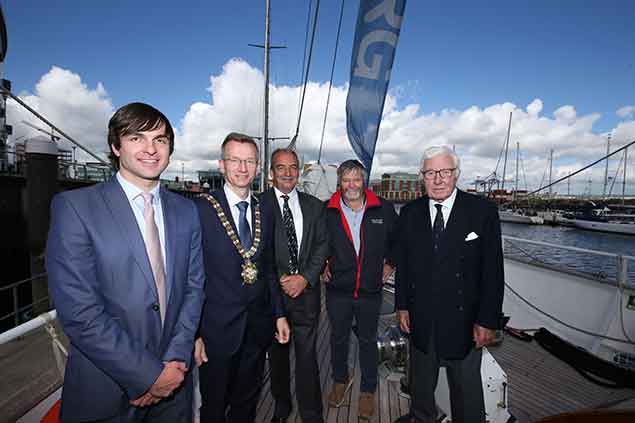 Atlantic Youth Trust in Belfast with (left to right) Neil O’Hagan, Lord Mayor of Belfast Brian Kingston, incoming AYT chairman Peter Cooke, President Enda O’Coineen, and outgoing chairman Lord Glentoran.
Atlantic Youth Trust in Belfast with (left to right) Neil O’Hagan, Lord Mayor of Belfast Brian Kingston, incoming AYT chairman Peter Cooke, President Enda O’Coineen, and outgoing chairman Lord Glentoran.
But since November, other things have happened. The collapse of the Stormont administration and the General Election last Thursday will have its effect. So will the possible changes of leadership south of the border. And while Enda O Coineen now has a largely honorary role in the Atlantic Youth Trust as President, public perception is so febrile that we can only guess at the effects – favourable or otherwise – his major setbacks and his courageous handling of them in the Vendee Globe race will have on the way people view the Atlantic Youth Trust.
Thus for the moment there’s a distinct vacuum where positive progress towards a joint-government-underwritten sail training ship for all Ireland might normally be found, and all too quickly, vacuums being what they are, all sorts of alternative solutions may be offered.
The trouble is that, when faced with a big traditional sailing ship and better still a square rigger - any square rigger, and preferably one with a magnificent clipper bow – people will lose the run of themselves in dreams. Dreams of sailing the seas as the great mariners of yore did before them. Dreams of introducing young people to the wonders of sail. Dreams of saving the planet through the healing effects of majestic rigs driving non-polluting tall ships cross the ocean.
Such dreams are getting thing entirely the wrong way round. Certainly you may be inspired by seeing a ship like the Europa making her handsome way down Befast Lough under full sail. But having seen her, that’s when the research work should start, the hard work behind the scenes to make it all a realistic proposition, and start working towards sustainable funding.
Yet it so easy to see the ship and get inspired and immediately involved without a thought for what it will cost in the long run. That’s probably how the elderly owner of the Astrid was drawn into the dreadful mesh. And in the north, they’ve two character ship ventures whose owners dream the dream, but whether either can ever become reality is another matter entirely.
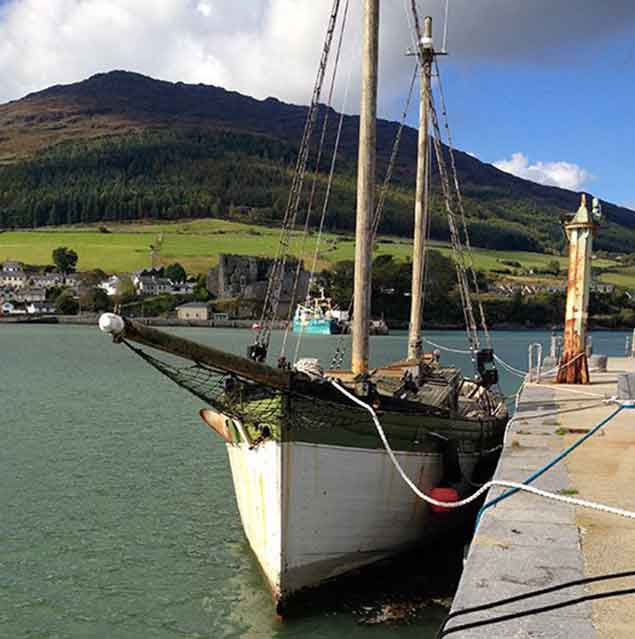 Dreamship? The characterful Silvery Light at Carlingford
Dreamship? The characterful Silvery Light at Carlingford
There’s a vessel called the Silvery Light in Newry, and she inspired those who saw her when she first arrived in Ireland alongside the quay in Carlingford. But now the owner seeks support from whatever source to make her fit to be a sail training vessel – we can only wait and see, for we have some idea of what a monumental task this is.
But in the little village of Portaferry, a tall ship dream has turned into disaster. We’ve carried stories of the sunken 130ft Regina Caelis on Afloat.ie in recent weeks, but things get no better.
Apparently she is owned by someone who bought her from a previous owner for just £1.The previous owner from Northern Ireland had bought her in Scotland, hoping to turn her into a tall ships dream to sail in warmer seas. But by the time he’d got her home to County Down, he realised it was beyond his ability to complete the work, so after he’d managed with great difficulty to get her berthed on the end of the little public quay at the south end of Portaferry, she was offered for sale for the nominal sum.
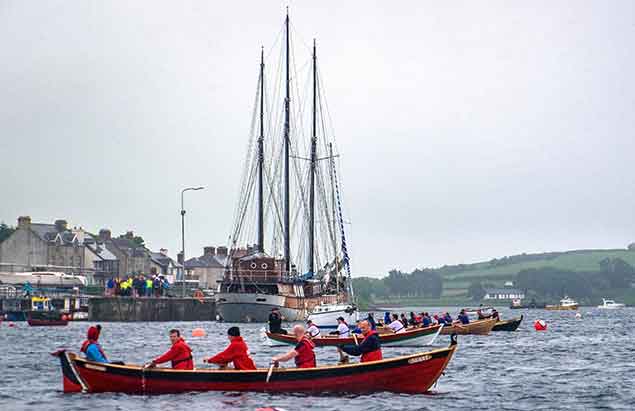 The elephant in the room, The 130ft Regina Caelis overstayed her welcome by many months when she effectively blocked off Cook Street Quay in Portaferry, making it difficult of access for the race officers in one of the local skiffie events, and unusable by any other boats…….Photo: Gary Lyons
The elephant in the room, The 130ft Regina Caelis overstayed her welcome by many months when she effectively blocked off Cook Street Quay in Portaferry, making it difficult of access for the race officers in one of the local skiffie events, and unusable by any other boats…….Photo: Gary Lyons
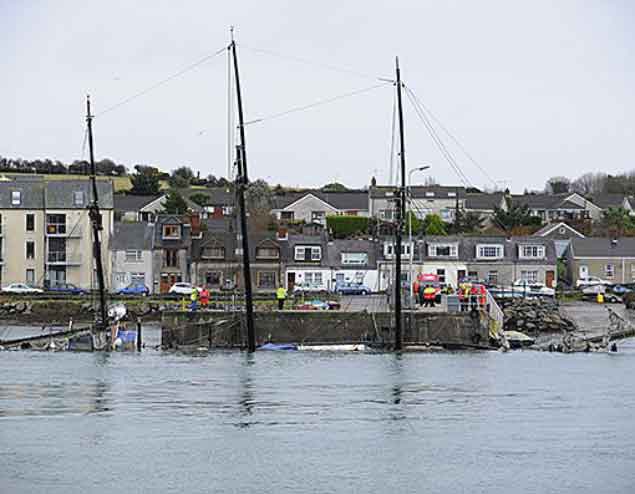 …….and then she went and sank, polluting Strangford Lough with 900 litres of diesel
…….and then she went and sank, polluting Strangford Lough with 900 litres of diesel
That was more than a year ago. Since then she has changed ownership for £1, but she continued to completely block off what should be an important local amenity, as Cook Street Quay – to give it its local name – traditionally provides free berthing, but its successful functioning depends on no-one abusing this valuable privilege.
Whatever about the good intentions when this ship the Regina Caelis arrived at the quay, berthed on it she is so out of scale that her bow sticks out at one end and her stern sticks out at the other, thereby impeding boat access to either side of a public pier. Staying there for more than a year soon became a matter of abusing a communal facility. But then it all became completely pear-shaped when she sank at the pier, gradually leaching 900 litres of diesel fuel into Strangford Lough, a very special nature reserve.
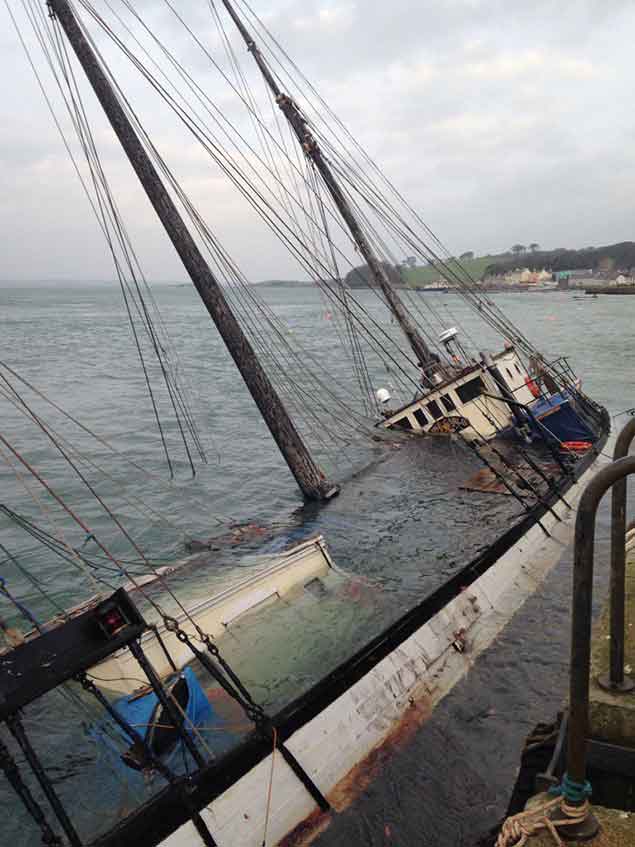 It would provide a perfect course in salvage techniques at some maritime university, but Portaferry could do without it
It would provide a perfect course in salvage techniques at some maritime university, but Portaferry could do without it
It’s now an environmental and neighbourhood disaster beyond belief. But with a free pier and in the absence of an active government, the position has been allowed to persist, while the optimistic owner has launched a crowd-funding initiative in order to raise his vessel and restore her to her full potential as a tall ship.
Seasoned observers reckon that it will indeed be a crowd-funding initiative which will solve the acute problem of the Regina Caelis slowly disintegrating at Cook Street Quay in Portaferry. But the crowd will be the much-put-upon taxpayers of Northern Ireland, and they’ll be in this crowd-funding project whether they want to or not.
Whatever the outcome, it’s all a very long way indeed from a properly researched and resourced sail training barquentine for the young people of all Ireland. And in its veiled hostility, it’s all an extremely long way away from the friendly efficiency of the annual Portaferry Sails and Sound music and traditional boat festival, which shows Portaferry at its best. In every way, it’s an excruciatingly unpleasant situation for a charming village. Portaferry deserves better.
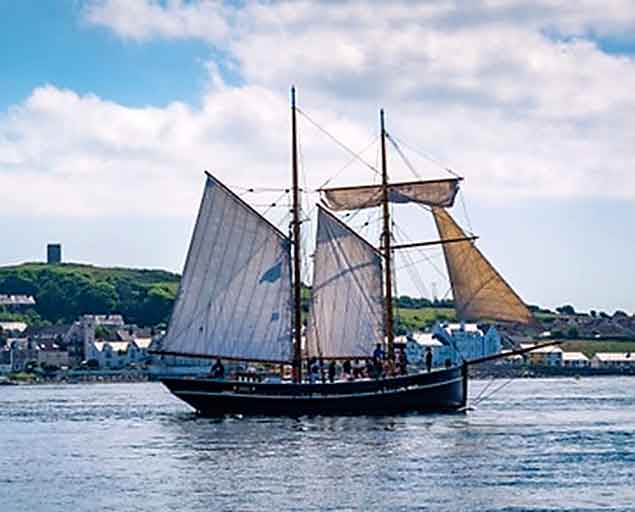 Portaferry in happier times, with Scott & Ruth Metcalf’s schooner Vilma off the town Photo: Neil Ritchie
Portaferry in happier times, with Scott & Ruth Metcalf’s schooner Vilma off the town Photo: Neil Ritchie
Tall Ships Under Sail on Dublin Bay
Tall Ships Earl of Pembroke from the UK and Morgenster (Holland) are among a fleet of six boats entering Dublin Port this lunch time in a parade of sail to mark the start of the annual River Liffey Festival. Joining the Tall Ships in Dublin Bay are schooners Sprit of Oysterhaven and Celtic Mist. More on the Dublin Port Riverfest here.
Tall Ship Sailing Chance Between Irish & Scottish Ports
Anyone aged between 16 and 28 who would like to sail aboard a Tall Ship is being offered the opportunity by Belfast City Council and Sail Training Ireland. As Afloat.ie previously reported, The Tall Ships, “Maybe” and “Morgenster” are the vessels on which voyages between Belfast, Scottish and Irish ports, will be available, as part of Belfast’s Maritime Festival. Applications are invited with a deadline of Friday, March 25.
Sail Training Opportunities In 2016
#TallShips - Sail Training Ireland has announced details of its tall ships voyages for youth sailors in 2016.
Three voyages are scheduled on board the 46m brig Morgenster in May and June – Cork to the Netherlands for under-18s (calling at Waterford and Wales), Belfast to Cork for over-18s (calling at the Isle of Man and Dublin) and an open delivery voyage from the Netherlands to Belfast.
Smaller crews will be welcomed on board the Dutch ketch Maybe for a series of 11-day voyages from April to June under the Leargas Youth Exchange programme for under-18, taking in Oban in Scotland, Belfast, Galway, Dublin and ports between.
In addition, the two established bursary schemes for young people in Ireland will hold their own voyages this summer, with the Drogheda Bursary Scheme scheduling two short adventure sailing trips on board the Spirit of Oysterhaven (Waterford–Drogheda and Drogheda–Derry), and the Cork Bursary Scheme sending participants on the same 70ft classic schooner around the South West.
During these five-day excursions young people will learn about the maritime environment, develop their sailing skills and challenge themselves both physically and mentally.
In addition, the 70ft ketch Brian Boru will embark on five discovery voyages for under-18s and over-18s between Waterford, Dublin and Drogheda beginning in March.
Places on these voyages are limited and expensive, but come part-funded thanks to local and European bursary schemes, individuals and sponsoring organisations, topped up by donations raised by each trainee.
Sail Training Ireland has more on its 2016 sailing training voyages HERE.
#tallship – With St Patrick's Day almost upon us, the westward trek across the Atlantic in search of American benevolence and funding for worthy objectives can become a very crowded pilgrimage. Among those looking for meaningful support for their pet projects, there will likely be proponents of some sort of new Tall Ship to replace the much-mourned brigantine Asgard II, and the ketch Lord Rank, both of which foundered in 2008 to leave Ireland - north and south alike - bereft of national sail training vessels.
Since then, there have been re-groupings of those who support the admirable concept of sail training for young people. In all, there may be as many as five different bodies on the island of Ireland which now provide access to the international programme. Coiste an Asgard itself was wound up in 2011, but it was immediately re-born as the Dublin-headquartered Sail Training Ireland, the national authority which carries the imprimatur of Sail Training International, the global body which co-ordinates and regulates all sail training.
The other main organisation, often functioning in tandem with Sail Training Ireland, is the Atlantic Youth Trust. It has offices in both Dun Laoghaire and Belfast, and has as its primary objective the construction and commissioning – for all Ireland – of a Class A 40-metre three-masted barquentine. WM Nixon continues with the story.
When we carried a history and analysis of Ireland's involvement with the International Tall Ship and Sail Training movement on this site on January 17th, the immediate response was formidable, and in favour. It continues to register hits at a rate which shows that the maritime community in Ireland has a real wish to see our own proper tall ship.
To achieve this ambition, in terms of having a clearly outlined plan the Atlantic Youth Trust is way ahead. With leading personnel from many parts of Ireland on its high-powered board of Trustees and Directors, the concept - originally inspired by Enda O'Coineen and John Killeen of Galway – is already becoming very complete.
Executive Director Neil O'Hagan and other have researched globally in order to analyse the success of more than two dozen national sail training schemes, and they have concluded that the best model to learn from is the Spirit of Adventure Trust in New Zealand, which functions through training based around the barquentine Spirit of New Zealand, which at 45.2 metres in "sparred length" is steel built registering at 184 gross tons, and carries 40 trainees.
The funding concept on the capital outlay for building the new ship for Ireland will ultimately rely on a total of €15 million being put up jointly by the two governments in the interests of inter-community and cross-border co-operation. Although the current turmoil in the Northern Ireland political administration might temporarily impair the onward progress of the plan, it seems to have a certain inevitable momentum, and highly-regarded Netherlands-based Dykstra Naval Architects have been retained on the project, as have their associates at Damen Shipyards, who may supply the vessel in flatpack form for final construction in Ireland.
As to running costs, the AYT point out that it will come out of current spending, as the vessel by nature of its work will be able to tap into government funds for social welfare and other youth schemes.
Faced with such a juggernaut of ideas, energy, contacts at top government level, and sheer enthusiasm, it seems churlish to question the validity of what is, after all is said and done, a magnificent project. But there are many in Irish sailing in general and sail training in particular who are concerned about the thinking on which it is all based.
To begin with, while we all admire the maritime spirit of New Zealand, does it make sense to draw conclusions for Ireland from a successful scheme in what is essentially a very isolated island nation? Ireland may be an island nation, but it's clearly wide of the mark to describe us as isolated, and this is reflected in the pattern of tall ships visit. If just six tall ships turn up at one port in New Zealand, it's regarded as a major event. But if less than sixty tall ships turn up at this year's Tall Ships Festival in Belfast at the beginning of July, then it will be regarded as a non-event.
In other words, Spirit of New Zealand usually functions in relative isolation, so it is not sail training as we know it in Europe. In fact, she is more of a floating school cum boot camp which happens to set sails, and in order to keep her very numerous trainee complement of 40 busy, while cruising in New Zealand waters (which she does nearly all the time), she is escorted by a large rib which frequently conveys the trainees ashore for land-bound ventures which sometimes out-balance their sea time.
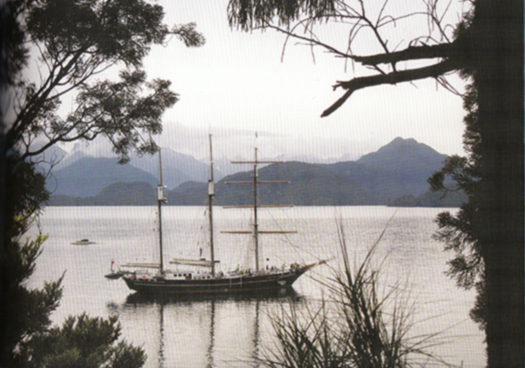
Alone, all alone.....the Spirit of New Zealand in a remote inlet on New Zealand's South Island. With forty trainees and a relatively easily-handled rig, she has a programme whch includes much shoreside activity. Photo courtesy STI
It's a very attractive programme in the New Zealand context, as they have many remote coastal areas which are virtually uninhabited and ripe for shore adventures which will not conflict with the rights of local inhabitants. But in Ireland and much of Europe such a programme would immediately meet problems, and for Ireland it makes more sense to follow the European pattern which puts an almost total emphasis on voyaging and sail training races.
Were a heavily-crewed vessel such as Spirit of New Zealand to do the European programme, there simply wouldn't be enough work for the 20 trainees on each watch to keep them happily occupied for long periods. Ideally, trainee tall ships are extremely labour-intensive for all hands, and in Europe that's the way it is done, but it needs what amounts to individual attention for each trainee.
So it's difficult to escape the conclusion that one reason for the attraction of the New Zealand scheme for the Atlantic Youth Trust is that it wins out in the numbers game. Forty young people taken out of troubled and aimless environments ashore, and sent away together on a voyage, is an impressive amount of social problems temporarily sorted in one fell swoop.
But will it be as behaviourally beneficial, in the long term, as it would be for a smaller number of people on a smaller and busier vessel? It will vary from case to case, but generally you'd reckon that the smaller more personal crew setup, with each trainee more directly involved in the sailing of the ship, would produce better results, while always remember that having as much square rig as possible is central to the concept.
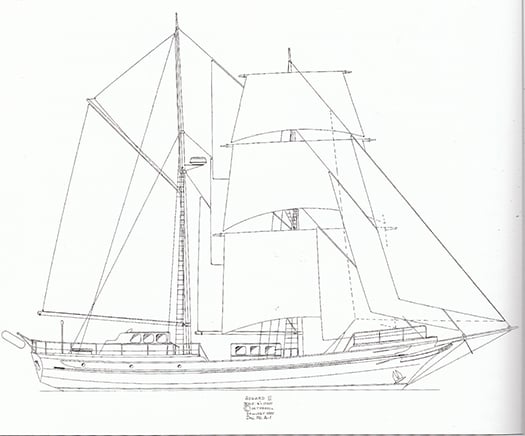
A timeless design which remains a very viable proposition for an easily managed ship which keeps her crew busy. Jack Tyrell's lines for Asgard II would lend themselves to construction in steel or even aluminium.
Ideally, to see Ireland's Tall Ship-owning reputation restored, many of us would like to see not just one newly-built replica of the 84ft brigantine Asgard II being launched, but three – one each for Cork, Dublin and Belfast. For, at the moment, the main axis of Atlantic Youth Trust activity seems to be between Dublin and Belfast. Yet as last weekend's National Annual Sailing Awards ceremony in Dublin so clearly underlined, Cork is really where it's at in terms of maritime development, and the lack of a significant Cork element seems to be a weakness of the AYT scheme.
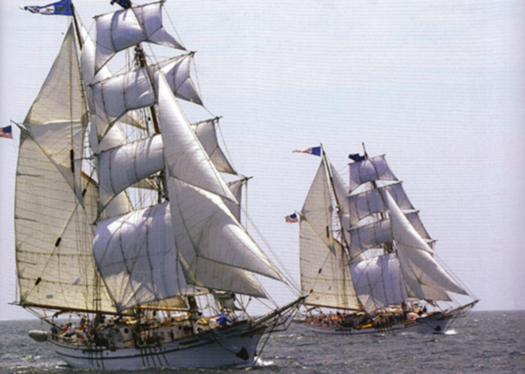
Might this be the way forward? One of our suggestions today is that Ireland really needs three Asgard IIs, based in Cork, Dublin and Belfast. We get an idea of how it might look with the two sister-ship American brigantines Exy Johnson and Irving Johnson, which are based in Los Angeles in California, where they were built in 2002.
Nevertheless, it says much for the dedication and energy of those promoting the Atlantic Youth Trust that we have the luxury of debating the validity of their plans, which have been so thoroughly developed. We may disagree with their conclusion, but it's not total disagreement – an Irish version of Spirit of New Zealand would be a very emphatic improvement on our present ship-less state, which is too much of a reflection of an ancient and negative mind-set.
Every time you see the Tall Ships gather and see how maritime countries of population comparable to Ireland, such as Norway, Denmark and Portugal, can send forth spectacularly handsome Tall Ships, it becomes a painful reminder of how the new Irish Free State increasingly turned its back on the sea.
The fact was admitted by Minister for the Marine Simon Coveney at last week's National Sailing Awards Ceremony in a speech which hinted at some very significant developments in the Irish maritime sphere in the near future.
But really, what Minister Coveney was talking about is that it is time and more for us to grow up in our attitude to the sea. When the Free State was struggling into being in 1922, the popular view was that British power was synonymous with sea power. So if you were against the sea and seafaring in all its manifestations, then you were demonstrating the purity of your patriotism through adopting what was essentially if subconsciously an anti-British stance. Childish perhaps. But we all know that's the way it was.
So despite the flurry of maritime enthusiasm which was engendered by national emergency during World War II to inspire the creation of Irish Shipping and the Maritime Inscription, what this meant was that when the underlying attitude genuinely began to change in the 1950s, a positive attitude towards the sea wasn't being built upwards from Ground Zero. It was being built from Ground Minus Thirty – the number of years that an anti-maritime attitude had been the unstated yet very real official policy.
Thus there was a period when Irish maritime enthusiasm had to be kept going almost as a secret cult, and I'd an odd reminder of this some weeks back at the annual Awards Ceremony of Sail Training Ireland. The Patron of STI is President Higgins, and the event was held – for the second year running – in the Mansion House in Dublin. Yet the very fact of the identity of their Patron, and of their event being staged in the Mansion House in the presence of Lord Mayor Christy Burke, provided such pleasure and pride for everyone in the gathering that it was a forceful reminder that, not so very long ago, seafaring was very much the poor relation in Ireland, and there were those in authority who would have happily air-brushed it out of the national picture entirely, leaving it to foreign crews to undertake the rough trades of the sea.
But thanks to those former members of Coiste an Asgard who refused to give up the vision of sail training for Ireland, even as the onset of economic Armageddon from 2008 to 2011 made any prospect of a new Asgard II a very distant vision as the government chucked the €3.8 million insurance payout into the bottomless pit of national debut, Sail Training Ireland arose like a Phoenix and set in place sail training bursaries for places on foreign tall ships, using international contacts built up during the 27 successful Asgard II years to ensure that Ireland could re-build our position at the heart of the movement.
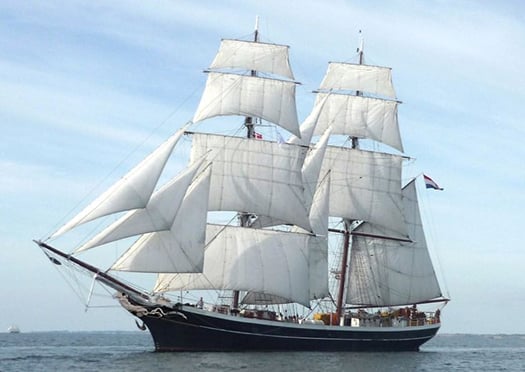
She keeps them busy....the Dutch brig Morgenster is superbly labour-intensive in the best sail training traditions. Photo courtesy STI
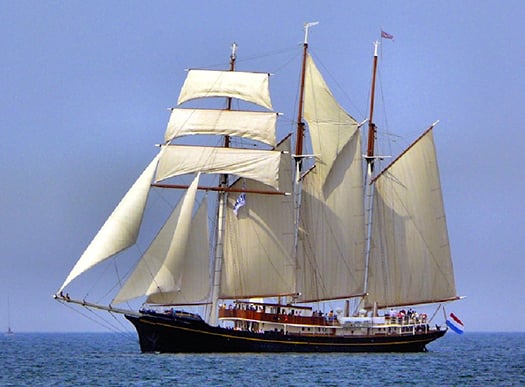
Gulden Leeuw is another of the Dutch Tall Ships which have been taking Irish trainees to sea on Sail Training International programmes. Photo: Courtesy STI
The thriving tall ships scene in the Netherlands – which has become a focal point for sail training and the Tall Ships industry for all Europe – proved the most fruitful placement area, with most Irish trainees being positioned aboard the very handsome 48 m (sparred length) brig Morgenster, which has become a familiar sight in Irish ports. Another ship well used is the three-masted topsail schooner Gulden Leeuw, a long slim craft as she is 70 m in sparred length, while that noted poster girl of Tall Ships sailing, the 56 metre three masted Dutch barque Europa, also carried Irish crew from time to time.
However, while placements on such vessels work very well, the hankering for an Irish sail training flagship is always there, and fortunately in recent years Oliver Hart's 70ft training schooner Spirit of Oysterhaven has been punching way above her weight in filling the role in gallant style with a varied programme on the Irish coast.
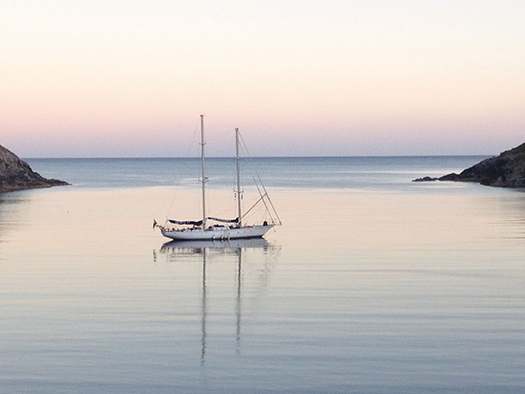
Spirit of Oysterhaven in South Harbour, Cape Clear Photo: Oliver Hart
This and much more was reflected in the Sail Training Ireland Awards Ceremony in the Mansion House, a goodly gathering which was representative not just of every possible aspect of sail training at home and abroad, but also of Irish ports which are increasingly interested in an activity which brings their ancient waterfronts vividly to life. And the progress of various ship projects was spoken for by everything from complete vessels such as the Basque Spanish schooner Atyla represented by Rodrigo de la Serna, through vessels in the making as personified by our own ketch Ilen. She has since seen her final new plank knocked ceremonially into place at Oldcourt in Baltimore, but here's an evocative video Gary MacMahon left with us of the creative planking process under way. And present too was Neil O'Hagan of Atlantic Youth Trust, whose organisation deservedly received recognition for their pioneering work towards a completely new ship.
{youtube}ZLT3D8TBbwk{/youtube}
The main awards presented in the Mansion House by STI Chairman Seamus McLoughlin, who is former Head of Operations for Dublin Port, were:
1. Trainee of the year: Andrew Crowley
2. Special Contribution Award: Turlough Kennedy
3. Special Achievement Award: Fiona Armson
4. Perpetual Asgard Award: For an outstanding contribution to, or achievement in Sail Training by an individual or group: Atlantic Youth Trust / Foroige Group of Trainees
5. Watch-leader of the Year: Sara Mason
6. Volunteer of the year: Jonathan O'Brien
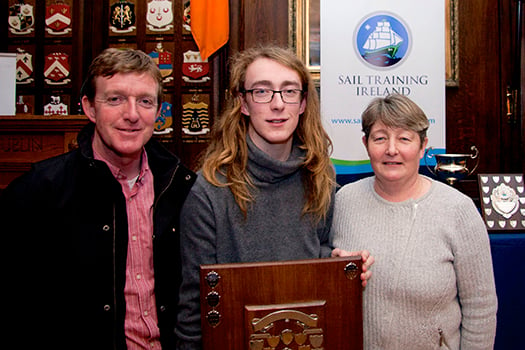
Trainee of the Year Andrew Crowley with his parents in the Mansion House
Trainee of the Year Award: Andrew Crowley
Andrew is Club Captain of the Spirit of Oysterhaven Trust. During 2014, he was instrumental in helping to organise the Club's sailing trips aboard Spirit of Oysterhaven with a special emphasis on providing opportunities for young people with disability. He helped to organise the Club's Youth in Action programme, and crewed aboard Spirit during the Irish Cruising Club's sponsored Anniversary voyage from Glandore to Glengariff with a crew of eight trainees, including several with disability. During the summer Andrew was a vital member of a short-handed crew delivering Spirit from Oysterhaven to Glandore during which he proved himself an outstanding active crew member.
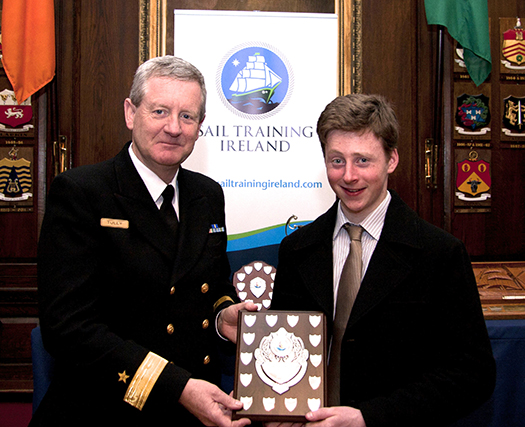
Commodore Hugh Tully, Flag Officer Commanding Naval Service, with Turlough Kennedy, who received the Special Contribution Award
Special Contribution Award: Turlough Kennedy
This year's special contribution award goes to Turlough Kennedy from the lakeside port of Scarriff in County Clare for the outstanding role he filled on the Dutch tall ship Morgenster.
To quote Michael Byrne, Director of Sail Training Ireland: "This contribution was not only recognised by us. On completion of last year's voyage Turlough - despite his limited sea going experience - was offered a crew member's berth on board the ship by the Captain. While he was not in a position last year to take up this offer for the remainder of the 2014 season, in 2015 we are delighted that Turlough will be sailing as voluntary crew on board the Morgenster. The following is a short note from the ship's Captain, Harry Muter: "Turlough sailed with us last year and he was very good good both in the sailing department as in the social processes. For his age he was surprisingly adult, patient and emphatic. And then the music, it coloured this voyage, and Turlough played a role with his complicated bagpipe and improvisation talent. Looking forward to sail with him again." " (There are no prizes for guessing that "complicated bagpipes" are Uileann Pipes).
Special Achievement Award: Fiona Armson
The special achievement award this year went to Fiona Armson for the tenacity and determination she showed by completing her 14 day voyage. Fiona found some aspects of life at sea a real challenge but despite being given several opportunities by her leaders and the crew to take on a lighter work load Fiona refused to leave her watch and pushed on.
Fiona completed her voyage having never missed a single watch or duty and, in a way that would put a smile on any sailor's face, she sailed the Gulden Leeuw into her home port of Bangor.
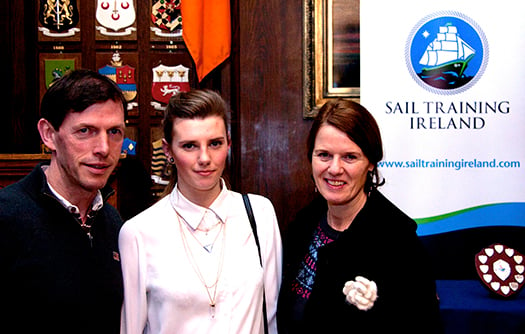
Special Achievement Award Winner Fiona Armson with her parents
Perpetual Asgard Award
Awarded to a group of four Foroige Trainees: Michael Collins, Dean Mc Keon, Brandon McDonagh, and Daniel O'Halloran,
In March 2014, four young people from Ballybane in Galway set out on a remarkable adventure, travelling half way around the world to experience the Spirit of Adventure's 10-Day Youth Development Voyage in New Zealand. Three youth workers accompanied the group for the three week trip, and one of them, Pearse O'Toole, was at the Mansion House with them. The trip was funded by a private donation and managed by the Atlantic Youth Trust and Foroige.
The group spent 10-days sailing around the magnificent Hauraki Gulf off Auckland on the barquentine Spirit of New Zealand. They adapted very well to their new surroundings as crew members and returned with fresh skills, more confidence than ever, and a new outlook on life and what is possible.
Neil O'Hagan, Executive Director of the Atlantic Youth Trust, followed this award with a presentation about the Peace and Reconciliation Fund-supported Sea-Connections scheme, and then the next award was remarkably appropriate, as it was for the Watch Leader of the Year and it went to Sara Mason for her very successful participation in an EU Youth Exchange Voyage on Gulden Leeuw.
Sara (pronounced saarah) is from the North Island of New Zealand, but now lives and studies in Dublin. She is part of the Shackleton Outdoor Adventure Management Diploma Course in Colaiste Dhulaigh in Coolock. She joined the team of youth leaders which facilitated the main voyage programme of Youth Exchange projects in May-June. As a leader on the Dutch Ship Gulden Leeuw, she cared for and facilitated a group of 40 young adults over a 14 day period. She was an outstanding support to them as a leader, and brought with her a set of skills that are unique to professionals who spend their lives working with people in the outdoor adventure industry. She also has a fantastic energy and enthusiasm and was an inspiration to the trainees and other leaders.
Volunteer of the Year Award - Jonathan O'Brien
Jonathan has become involved in a multitude of voluntary activities with Sail Training Ireland in the last year. In 2013 he volunteered as a youth leader for one of STI's youth exchange voyages for 10 days from Belfast to Dublin. In 2014 he was head-leader across youth exchange voyages with a total of 8 leaders, with at times up to 100 trainees across three ships seeking his support.
Having a background in both outdoor education and in social care, Jonathan has an exceptional set of skills that lend themselves very well to the role of leader on a tall ship, and he has now found himself "volunteered" for a position on STI's sub-committee for trainee programmes. During 2014, he also spent time on a number of ships across Europe, while somehow also fitting in a spell serving as First Mate on the Spirit of Oysterhaven. He is helping to develop on-board programmes for a number of STI's funded voyage schemes during 2015, and will also train STI's group of twelve youth leaders in April.
So the good work goes on, but the more of it there is, the more it become apparent that Ireland needs her own tall ship, and the sooner the better. A programme of international placement may work very well for those in the know, but for people down the country which are remote from maritime communities, it often takes the stimulus and sense of pride engendered by an Irish ship to make that first move afloat.
It was summed up so well by investigative academic and journalist Dr Elaine Byrne in our story about the Tall Ships on January 17th that it deserves repeating here. Usually in her line of work, Elaine Byrne takes no prisoners. But the quiet depth of feeling underlying the brief story of how the Byrne family from the deepest rural depths of County Carlow became involved in sail training has a resonance for us all today:
"I'm the oldest of seven children from a farming family on the Carlow/Wicklow border, where the household income is augmented with a funeral undertaking business attached to a pub in which I might still work on visits home. Our background is just about as far as it's possible to be from Ireland's maritime community. Yet thanks to Asgard II, I was able to take a step into the unknown world of the high seas as a trainee on board, and liked it so much that over the years I spent two months in all on board, graduating through the Watch Leader scheme and sailing in the Tall Ships programmes of races and cruises-in-company.
Down in the depths of the country, my new experiences changed the family's perceptions of seafaring. Four of my siblings then had the opportunity to sail on Asgard II. If it were not for Asgard II, my family would never have had the chance to sail, as we did not live near the sea, nor had the financial resources to do so. The Asgard II played a large role in our family life as it became a Rite of Passage to sail on board her. My two youngest siblings did not sail on Asgard II because she sank, which they much regret.
Apart from the discipline of sailing and the adventure of new experiences and countries, the Asgard II brought people of different social class and background together. There are few experiences which can achieve so much during the formative years of young adulthood".
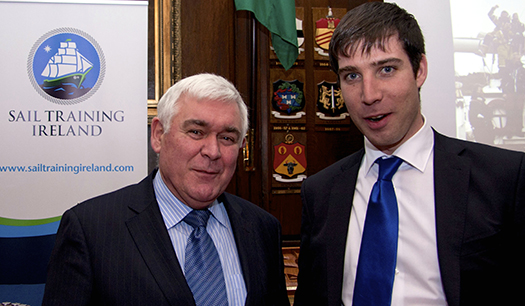
Seamus McLoughlin, Chairman of Sail Training Ireland, with Michael Byrne, Director.
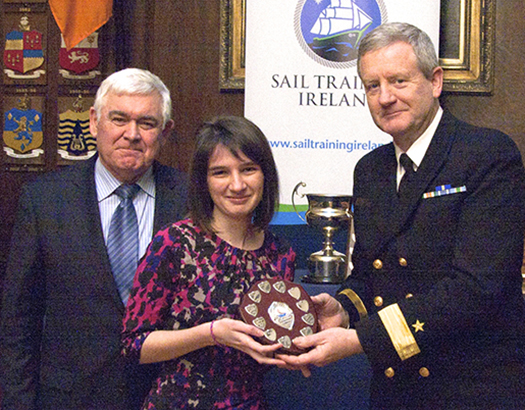
Carolanna Foley, awarded a Drogheda Port Sail Training Bursary, with Seamus McLoughlin (left) and Commodore Hugh Tully
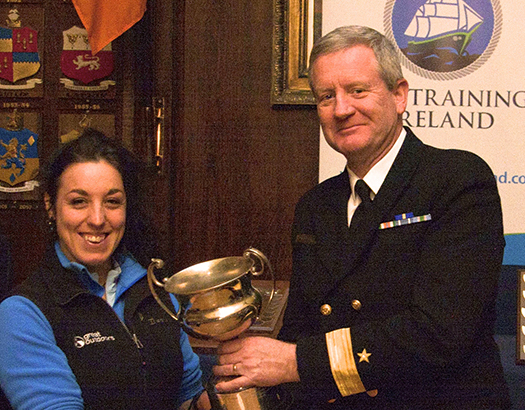
Sara Mason, Watch Leader of the Year, with Commodore Hugh Tully
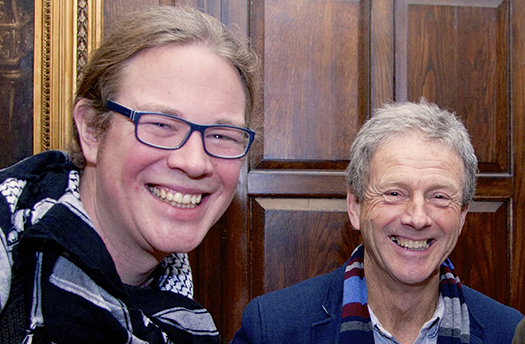
Jonathan O'Brien (left) Volunteer of the Year, with Oliver Hart
- Sagres
- Tall ship
- Coiste an Asgard
- Atlantic Youth Trust
- barquentine
- Sail Training Ireland
- Sail Training International
- John Killeen
- Enda O'Coineen
- Neil O'Hagan
- Dykstra
- Damen Shipyard
- sailing
- Simon Coveney
- Lord Mayor
- Phoenix
- Spirit of Oysterhaven
- Europa
- Morgenster
- Gulden Leeuw
- Basque Spanish schooner Atyla
- Ilen
- Elaine Byrne
- Oysterhaven
- Mansion House
- Christy Burke
- World War II




























